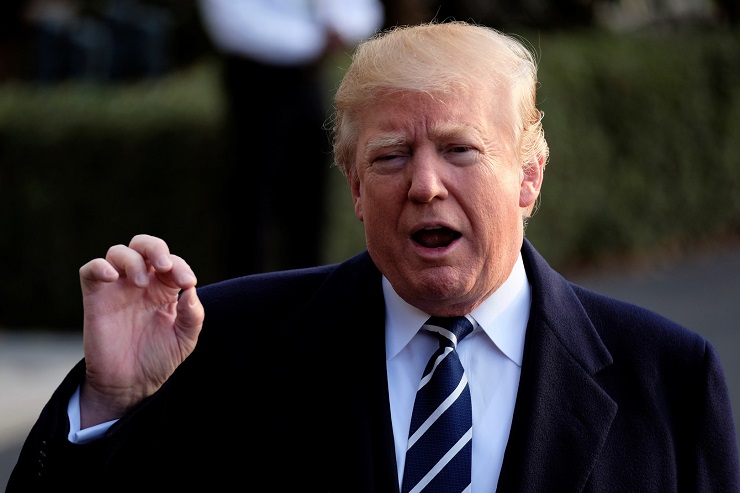
Washington’s Latest Myths, Lies and Oil Wars
By F. William Engdahl
6 July 2018
As American motorists complain of rising gasoline prices, the Trump Administration and the oil and banking interests behind it are smiling on their way to the proverbial bank. If we look at seeming disparate events in Iran, in Venezuela and now in Libya it becomes clear there is a coherent strategy to promote disruption in key oil flows to the immediate advantage of US oil domination .
A decade ago the idea that the United States could displace Saudi Arabia or the Russian Federation as the world’s largest oil producer was considered unthinkable. Today it is clearly a foreign policy priority of the Trump Administration and the major Wall Street banks financing US shale oil production. The strategy is geopolitical and ultimately aims to weaken Russia, Iran and the other independent world oil producing powers like Venezuela.
If we look at several recent events that have dramatically impacted global oil prices a clear pattern emerges not of free market forces but of geopolitical manipulation, above all by Washington. The cases of Iran, of Venezuela and most recently of Libya make the case clear that Washington is determined to push an oil price high enough to again make economical investment in its developed shale oil industry.
Iran not about nuclear but oil
The obvious point about the Trump administration unilateral rejection of the Iran nuclear agreement, an agreement that was to have enabled Iran to be free from Western economic sanctions and open the way for billions of dollars of foreign investments, above all in her oil and gas industry, is the fact that it had nothing to do with Iran’s nuclear plans per se. It has immediately to do with an excuse to re-impose economic sanctions on Iran oil sales and oil and gas development.
Ignoring UN IAEA reports finding Iran compliant with the nuclear agreement, the Trump Administration in May unilaterally announced a de facto end to the agreement to the protests of EU, Russia and China signatories. On November 4, barring an unlikely Iran capitulation to Washington demands, severe new sanctions targeting mainly Iran oil exports will come into force. Washington is linking its actions to Iran’s agreeing to withdraw support for Shi’ite forces in Yemen and Assad in Syria. Since the nuclear agreement, Iran’s state oil company has managed to rebuild oil exports to almost 4 million barrels daily, near the pre-sanction levels. Through secondary sanctions Washington is making clear EU or other companies aiding Iran to continue oil exports will be sanctioned in any business in the US, a hard hurdle. Already the French energy giant Total has said it will end its joint venture in Iran’s huge energy sector.
On July 2, a senior US State Department official made clear Washington aims in Iran: “Our goal is to increase pressure on the Iranian regime by reducing to zero its revenues from crude oil sales. We are working to minimize disruptions to the global market, but we are confident that there is sufficient global spare oil production capacity.“
Venezuela as well
At the same time the Trump administration renews targeting Iranian oil in world markets, with a delay until November, it is encouraging the complete collapse of the Venezuela oil production as part of Washington’s ongoing financial and political war against the Maduro government.
At the time of the latest Venezuelan election victory of incumbent socialist President Maduro, Washington escalated sanctions that cut off all access of state oil company PDVSA and Venezuela to US banks, as well, cutting off all refinancing of new debt. Prior to the recent OPEC ministers meeting, Venezuela Oil Minister Manuel Quevedo declared, “These sanctions are very strong, the sanctions are practically immobilizing PDVSA…It’s an attack on the oil market .” According to the International Energy Agency, Venezuela oil production averaged 1.36 million barrels of oil daily in June, down from 2.9 million bpd five years ago.
Then with convenient timing, the major US oil company ConocoPhillips seized about $636 million in assets belonging to Venezuela’s state oil company PDVSA due to a2007 nationalization of the US oil major’s projects in Venezuela. The seizure has blocked PDVSA from meeting its export obligations and creating tanker bottlenecks at Venezuelan ports. To counter significant loss in Venezuela oil imports, China’s Development Bank has just announced a US$5-billion loan for Venezuela’s oil industry. Among the major importers of both Venezuela and Iran oil is China, a fact well known to the US Treasury and State Department .
And Libya nowWhile oil traders have reacted to the supply reductions in both Iran and Venezuela sending prices for various grades of crude oil sharply higher above $70 for the first time in three years, the market situation, seen from the standpoint of the US oil industry, especially shale oil, is not yet secure. That is changing, however, given recent developments in Libya.
Ever since Washington’s “humanitarian” bombing of Qaddafi’s Libya, then one of the most economically advanced countries in Africa, the country has been in a de facto civil war and political division. On the one side is a UN-imposed and Washington supported regime in Tripoli, a deceptively-namedGovernment of National Accord, under an appointed Prime Minister and alsohead of the Presidential Council (PC), Fayez Al-Sarraj. Al-Sarraj is backed by the Muslim Brotherhood, the secretive political Salafist organization behind the Washington-backed Arab Spring and the Mohammed Morsi regime in Egypt. The Tripoli group is also backed by the USA, UK and France.
Al-Sarraj’sprime opponent is Field Marshall KhalifaHaftar who has de facto established military control through the anti-Salafist Libyan National Army, with backing of key tribal leaders in the oil-rich eastern Libya and who is backed by the elected Libyan Libyan House of Representatives (HOR).
Haftar, a bitter foe of the Muslim Brotherhood whom he calls terrorists, has de facto established military control in the eastern part of the country in the Oil Crescent. When his forces tookcontrol of key sections of eastern Libya in recent days, including the vital oil ports atHariga and Zueitina, Haftar went in direct opposition to the Tripoli US-backed regime and announced that control of the eastern oil ports would go to the separate Benghazi-based National Oil Company, affiliated with the eastern government, which is not recognized by the UN. At that point, with Washington backing, the Tripoli Western NOC declared force majeure over the eastern ports and brought shipments of up to 850,000 barrels/day of Libyan oil off the world market on July 2 .
Haftar’s army is known to be very close to Egyptian President al-Sissi, also a bitter foe of the Muslim Brotherhood. Haftar also has good relations with Putin’s Russia. Preventing Haftar’s forces in the oil-rich east from creating a parallel oil economy independent of the US-backed Tripoli regime is adding to the dramatic change in global oil markets and is almost certain to push world market prices well above $80 a barrel, to levels not seen since 2014.
Conveniently that would be a profitability level that would give a huge boost to US shale oil output.
US Shale: a New Oil Geopolitics?
Scott Sheffield the chairman of the Texas-based Pioneer Resources, one of the largest US shale oil producers, in a recent interview in Vienna during the recent OPEC meeting, declared that before the end of this year, that the United States will pass Russia to become the world’s largest oil producer. He stated that US production will exceed 11 million barrels daily in 3-4 months and could “very quickly” reach 13 million bpd, and 15 million bpd within seven or eight years, based on production of shale oil from places like the Permian Basin in Texas. He stated that the most favorable price for shale right now is in a range of $60 to $80 a barrel . Could it be that by targeting the oil supplies of Iran, of Venezuela and now of Libya the influential energy companies behind the Trump foreign policy, are aiming to insure that US shale oil floods the world market in coming months to displace not only that oil but also, increasingly, Russian oil?
Notably, Iran has accused the United States of withdrawing from the JCPOA in order to raise the price of oil. On May 11, Iranian oil minister BijanNamdarZangemeh declared “President Trump playing double game in oil market. Some OPEC members playing into US hands. US seeking to boost shale oil production.”
The longer-term problem with the Washington oil domination strategy is the uncertainty of shale oil supply. While technology investment in recent years has improved well productivity and production rates, shale oil has major problems. One is that a given shale or tight oil well depletes far more rapidly than a conventional oil well, with production declines of 75% or more after the first year typical. To maintain overall volume then, more wells and more expensive wells are required. The other limit is the high requirement for added well water for fracking, in some places like Permian Basin, 5 barrels of water per barrel oil. Industry reports suggest that beginning 2020 the golden years of shale oil production in the US will be over as rising costs, lower quality acreages and other constraints limit shale oil growth and with it US oil output . That will have a major negative impact on the current Trump Administration strategy to make America the great oil king. It is a strategy ultimately built on myths, lies and, yes, oil wars.
F. William Engdahl is strategic risk consultant and lecturer, he holds a degree in politics from Princeton University and is a best-selling author on oil and geopolitics, exclusively for the online magazine “New Eastern Outlook”
